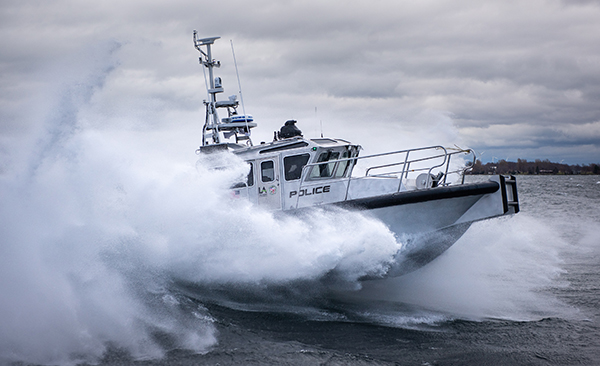27 Apr The Port of Los Angeles adds new MetalCraft Marine state-of-the-art CBRN asset to its fleet of patrol boats
The LA Port Police Boat is one of a new breed of CBRN detection patrol boats. A very fine bow entry is the critical design feature of all the Interceptor model line. Its high-speed rough water performance allows the operators to go offshore to inspect incoming ships before they enter the Port for nuclear and chemical hazardous contaminants.
The boat is designed for rough water with structure design to ISO 12215 and equally important, stability to ISO 12217 Category B. Cat B means it can work safely in 13-17’ waves. The boat has a very tall mast for restricted in maneuverability lights or tow lights. It has exceptional visibility meeting ABYC sight lines. Its spotter windows are designed to clearly see the ship’s upper superstructures and sheerline. The unique feature is that in a hard overturn the side spotter windows give the operator an unobstructed view to either port or starboard while at 45 degrees heel.
 The propulsion system is designed around reliability and ease of maintenance and includes the robust and reliable Cummins 6.7L engines at 480 HP and Konrad heavy duty 680 duo-prop outdrives. This combination provides an exceptionally spacious engine room and easy access to all service points minimizing down time for servicing. Oversize engine hatches provide access to all sides of the engines.
The propulsion system is designed around reliability and ease of maintenance and includes the robust and reliable Cummins 6.7L engines at 480 HP and Konrad heavy duty 680 duo-prop outdrives. This combination provides an exceptionally spacious engine room and easy access to all service points minimizing down time for servicing. Oversize engine hatches provide access to all sides of the engines.
The boat is fitted with an aft deck helm, which allows an operator to be part of a boarding exercise or water rescue and provide additional support. The boat has a portable 900lb davit for body recovery. The wide body version of the Interceptor line provides comfortable seating for three Officers and extra seating for a boarding party or mass rescue. The boat has overwide side decks with cabin access from near normal size sliding doors. These large doors provide good ingress/egress and for use with side arms.
The boat has a high-speed stainless deck windlass for when the boat is at anchor and surveilling the harbor and its entrance. It can bring up the anchor at a rapid rate safely with no chance of fouling to let the crew get underway immediately.
The electronics selection was the latest Furuno Timezero navigation system, with 16” displays at the helm and a giant 24” screen at the command/navigation station. The Timezero system is virtually instant at responding to new crew commands, with overlays so clear and intuitive that you really don’t need additional training on these units. A four-way split screen permits navigation information, CCTV cams and infrared cam info simultaneously. 
The boat has two very powerful CBRN detection units that are the highest-level state of the art detection systems available and are military grade.
The RAD System:
The RAD system was supplied by Radiation Plus. The RS-700 has a Gamma and Neutron detection system. The unit has an integrated controller and data acquisition system. The heart of the RS-700 is the proprietary advanced digital spectrometer (ADS) module. Using a unique detector energy calibration curve stored in the ADS module, the spectrum is linearized and compressed into the system’s 1024 channel resolution.
A high-speed processor allows data to be corrected if necessary without distortion and can process 250,000 characters per second. All data is posted to the RAD Assist software with mapping and Nuclide Identification features. http://www.radiationsolutions.ca/wp-content/uploads/2019/02/RS700-Feb- 2019.pdf
The Chemical Detection System:
The RAPIDplus chemical detector by Bruker is the second piece of this powerful CBRN patrol boat. It can automatically Detect, Identify and Monitor all known Chemical Warfare Agents (CWA) and important Toxic Industrial Chemicals (TICs) at long distances. Long distances means at 3.1 miles distance.
 The system can provide real time detection. The instruments utilise Bruker’s proven RockSolid™ flex-pivot interferometer and can be operated whilst static or on the move with no degradation in performance. The software provides the user with enhanced visual surveillance and analytical displays overlaid on video with an extended substance library and increased detection capability.
The system can provide real time detection. The instruments utilise Bruker’s proven RockSolid™ flex-pivot interferometer and can be operated whilst static or on the move with no degradation in performance. The software provides the user with enhanced visual surveillance and analytical displays overlaid on video with an extended substance library and increased detection capability.
The chemical detection limits of the remote sensor for CWAs and TICs are in the low ppm range and the new enhanced list of chemicals in the library is comprehensive. The system requires minimum training and maintenance and utilises operator friendly software that allows easy control of the instrument and interpretation of data. The RAPIDplus software provides enhanced analytical displays that visualise a hazardous cloud as an overlay on video and allows enhanced interrogation of the detection and manipulation of the hazard. https://www.bruker.com/






